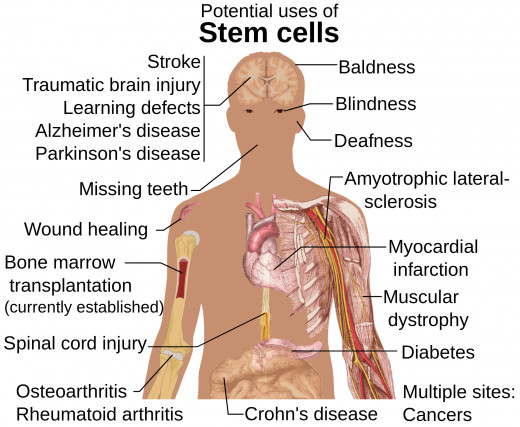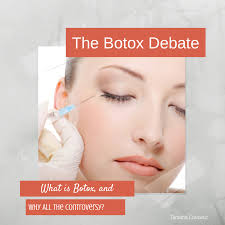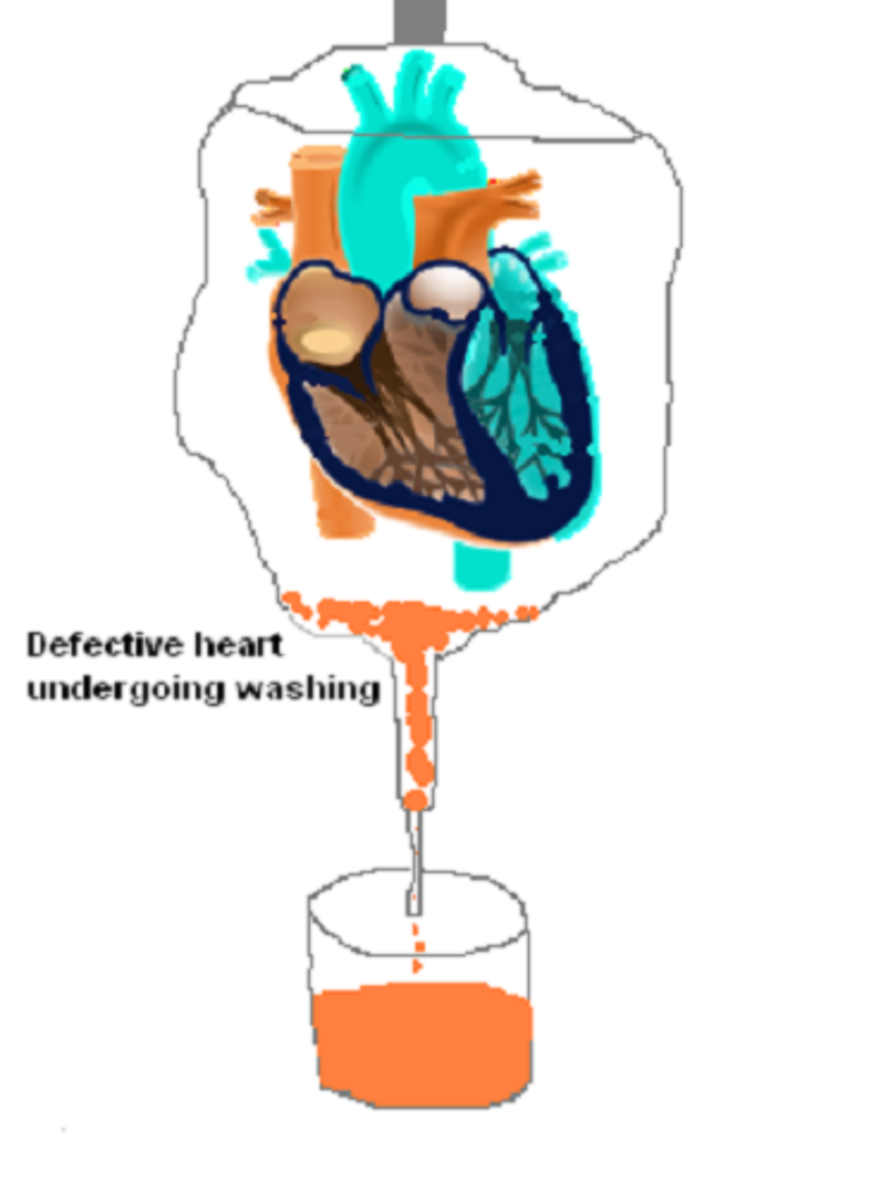Stem Cell Controversy and the Botox Controversy
A stem cell is a type of nonspecific cell that has the amazing ability to develop into any number of specialized cell types. Many scientists believe they show promise in the treatment of many types of diseases and health conditions. Research what scientists have learned about the potential uses of these cells. In a journal entry, explain the basis of the controversy and what your take is on it now that you understand the science better. How do you feel about their use?

A stem cell is an immature cell that has the potential to become specialized into different types of cells throughout the body; there are two main types of stem cells: adult stems cells and embryonic stem cells (Basics of Stem Cell Research, 2014). Adult stem cells are found in small numbers in adult tissue such as: the brain, bone marrow, blood vessels, skeletal muscle, skin, teeth, heart, gut, liver, and other (although not all) organs and tissues (Where do we get adult stem cells?, 2014). Embryonic stem cells are created when a newly fertilized egg begins to divide, this usually happens when the embryo are three to five days old (Stem cell transplant, 2014). Stem cell research has the potential to be used to prevent or cure certain diseases and injuries such as: Parkinson’s disease, type 1 diabetes, heart disease, spinal cord injury, Duchene’s muscular dystrophy, Alzheimer’s disease, strokes, burns, osteoarthritis, rheumatoid arthritis, vision, and hearing loss (Basics of Stem Cell Research, 2014). Even with the possible medical benefits there is still much controversy surrounding stem cell research and treatment.
The main controversy surrounding stem cell research is focused on embryonic stem cells because this research involves the destruction of the embryos or blastocysts formed from laboratory-fertilized human eggs (Phillips, 2014). The controversy comes from those who are of the belief that life begins with conception and that destroying the blastocyst is killing a human life. There is not much on controversy over the use of adult stem cells as the research does not harm any living beings, however people do fear that adult stem cell research will lead to an increased desire for more embryonic stem cell research. There are downfalls to adult stem cell research; adult only have a limited quantity of stem cells and those stem cells have a limited flexibility.
After reading about the controversial issues involved in Stem Cell research I feel that the advantages of stem cell research outweigh the disadvantages. Embryonic stem cell research does involve the destruction of a three to five day old laboratory-fertilized embryo. However I do not believe that the embryo would be considered alive at three to five days old because embryos are not even detected by pregnancy tests until they are at least twelve days old nor do they have heartbeats until they are at least six weeks old (Embryo Become a Fetus, 2014). Adult stem cell research does not involve the same great controversy as embryonic stem cell research and I feel that while the research may not be as ground breaking as the research on embryonic stem cells it should still continue in the hopes of finding methods of disease prevention and cures.

Do you think research into embryonic stem should continue?
References
Basics of Stem Cell Research. (2014). Retrieved November 7, 2014, from http://www.ama-assn.org/ama/pub/physician-resources/medical-science/genetics-molecular-medicine/related-policy-topics/stem-cell-research/basics-stem-cell-research.page?
Embryo Become a Fetus? (2014). Retrieved November 8, 2014, from http://www.uniqueultrasound.com/embryo-become-a-fetus
Padraig. (2012, April 26). The Cons of Adult Stem Cell Research. Retrieved November 7, 2014, from http://www.stemcellsuniverse.info/the-cons-of-adult-stem-cell-research/
Phillips, T. (2014). Stem Cell Research: Weighing Both Sides of the Debate. Retrieved November 8, 2014, from http://biotech.about.com/od/bioethics/i/issuestemcells_2.htm
Stem cell transplant. (2014). Retrieved November 7, 2014, from http://www.mayoclinic.org/tests-procedures/stem-cell-transplant/in-depth/stem-cells/art-20048117
Where do we get adult stem cells? (2014). Retrieved November 7, 2014, from http://stemcell.childrenshospital.org/about-stem-cells/adult-somatic-stem-cells-101/where-do-we-get-adult-stem-cells/
More and more people are turning toward cosmetic options to reduce signs of aging, particularly those relating to the skin. Consider what you read in your text about cosmetic procedures and the skin, and take a look at the American Society for Plastic Surgeons website's list of cosmetic procedures. Look over the ones that apply to the skin (microdermabrasion, skin resurfacing, dermal fillers, dermabrasion, chemical peel, and botox).

Botox also known as Botulinum Toxin type A is a “toxin produced by the bacterium that causes botulism, a dreaded form of food poisoning” ” (Marieb, 2012, p. 118). Small doses of Botox blocks muscular nerve signals which in turn weakens the muscles in the injected area so that they cannot contract causing a reduction in wrinkles (American Society of Plastic Surgeons, 2014). Botox does not fill in facial lines rather it only makes it difficult for the facial muscles to contract for about three to four months according to board-certified dermatologist Dr. Misbah Khan (Brooker, 2013). Botox injections can cause: bruising and pain at the injection site, flu-like symptoms, headache, nausea, redness, temporary facial weakness or drooping, breathing problems, trouble swallowing, excessive tearing, muscle weakness, and slurred speech (American Society of Plastic Surgeons, 2014. In some cases the effect of the botulinum toxin spreads to the rest of the body causing botulism-like signs and symptoms such as: muscle weakness all over the body, vision problems, trouble speaking, difficulty swallowing, trouble breathing, and/or loss of bladder control (Mayo Clinic, 2014).
Botox has become so widely used that there is now a black market for Botox which allows medical professionals as well as ordinary people to purchase and administer Botox to customers without having any training on how to administer Botox. An untrained person administering Botox could administer the Botox in the wrong part of the face causing a lopsided facial appearance. The administer could also administer too much Botox causing the muscles to become so weak that they can't support the skin which leads to an unnatural look, pain, difficulty holding the head up, and trouble swallowing (Brooker, 2013). Unskilled administers often forget or do not know to inform their patients to abstain from aspirin and fish oil prior to the procedure to prevent facial bruising and to keep their head lifted upward for at least two hours after the procedure (Brooker, 2013). The Botox purchased on the black market could also be expired or mixed with unknown compounds which could cause serious medical problems for the patient including, but not limited to itching, rashes, welts, asthma symptoms and/ or feeling faint (Brooker, 2013).
Knowing all of this I personally feel that Botox is not a good choice as the procedure only lasts three to four months and has no long term effects. Also there is the fact that Botox is “toxin produced by the bacterium that causes botulism, a dreaded form of food poisoning” (Marieb, 2012, p. 118). The procedure can be relatively safe when performed by a trained physician or dermatologist with a legal supply of safe Botox, but is three to four months without major wrinkles worth the risk?
Do you think the risks are worth the benefits of Botox?
References
Booker, K. (2013, July 5). There's a black market for Botox & other things to know before getting injected. Retrieved November 6, 2014, from http://www.today.com/style/botox-dangers-what-know-and-avoid-I538748
Botox injections Risk. (2014). Retrieved November 6, 2014, from http://www.mayoclinic.org/tests-procedures/botox/basics/risks/prc-20009036
Botulinum Toxin Minimally Invasive Procedure. (2014). Retrieved November 6, 2014, from http://www.plasticsurgery.org/cosmetic-procedures/botulinum-toxin.html
Marieb, E. (2012). Essential of Human Anatomy and Physiology (10th Ed.). San Francisco: Pearson Education.






